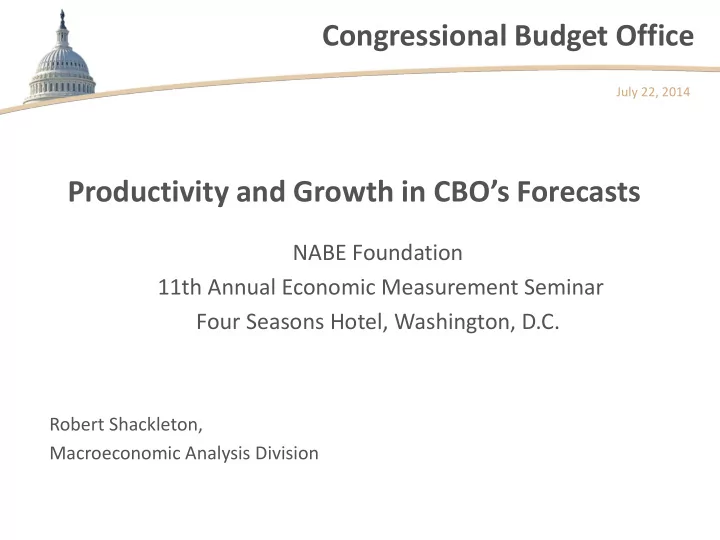

Congressional Budget Office July 22, 2014 Productivity and Growth in CBO’s Forecasts NABE Foundation 11th Annual Economic Measurement Seminar Four Seasons Hotel, Washington, D.C. Robert Shackleton, Macroeconomic Analysis Division
CBO’s Economic Outlook ■ What is CBO and why does it produce an economic forecast? ■ How does CBO’s role influence its forecast? ■ How does CBO prepare its economic forecast? C O N G R E S S I O N A L B U D G E T O F F I C E
The Purpose of CBO’s Macroeconomic Forecast ■ Used primarily in baseline federal budget projections and budget analysis ■ Gives 10-year “current law” projection – Current law may involve major changes in future policy – Example: in past years, current law implied a major shift in fiscal policy in 2013 C O N G R E S S I O N A L B U D G E T O F F I C E
CBO’s Approach to Forecasting ■ The long-term projection of potential output is based on a neoclassical growth model along with a near-term business- cycle projection using a standard macroeconometric model. ■ The long-term projection is an estimate of potential output based on estimates of the potential labor force, the flow of services from a capital stock, and potential total factor productivity. ■ CBO uses data from a wide variety of sources to form its estimates. C O N G R E S S I O N A L B U D G E T O F F I C E
Overview of CBO’s Growth Model Q NFB = F [L NFB , K NFB , TFP NFB ] Where ■ Q NFB = real gross domestic product in the nonfarm business sector ■ L NFB = index of hours worked ■ K NFB = index of real capital services from nine different types of capital assets ■ TFP NFB = total factor productivity (a residual) C O N G R E S S I O N A L B U D G E T O F F I C E
Labor Productivity Growth Equation % Δ ALP = %Δ TFP + α ( %Δ (K/L)) Where ■ ALP = average labor productivity ■ α = the coefficient on the capital services index in the production function C O N G R E S S I O N A L B U D G E T O F F I C E
Nonfarm Business Total Factor Productivity (2000 = 1.000) C O N G R E S S I O N A L B U D G E T O F F I C E
Contributions to the Revision of CBO's Projection of Potential Output for 2017 Between 2007 and 2014 (Percentage points) Revisions to Fiscal Policy Recession and Reassessment Prerecession and Other All Weak Recovery of Trends Data Factors Sources Nonfarm Business Sector Potential labor hours -0.7 -3 -0.3 1.2 -2.7 Capital services -0.6 -0.7 0.2 -1.3 -2.4 Potential total factor productivity -0.5 -0.7 -0.6 0.4 -1.4 Other Sectors n.a. -0.3 0.7 -1 -0.7 _____________ _____________ _____________ _____________ _____________ Total (Percent) -1.8 -4.8 -0.1 -0.7 -7.3 C O N G R E S S I O N A L B U D G E T O F F I C E
Key Estimates in CBO’s Projection of Potential GDP (February 2014) (Percent, by calendar year) Historical Periods Projection 1950- 1950- 1974- 1982- 1991- 2002- 2014- 2013 1973 1981 1990 2001 2013 2024 Aggregate Potential output 3.30 3.96 3.29 3.15 3.19 2.23 2.13 Potential labor force 1.48 1.56 2.49 1.60 1.26 0.75 0.54 Potential labor productivity 1.80 2.36 0.78 1.53 1.91 1.46 1.58 Nonfarm Business Sector (NFB) Potential output 3.54 4.05 3.69 3.29 3.60 2.54 2.54 Potential hours worked 1.32 1.35 2.37 1.58 1.21 0.46 0.55 Capital services 3.75 3.90 4.06 4.04 4.33 2.52 3.07 Potential total factor productivity 1.46 1.90 0.80 0.96 1.44 1.45 1.23 Memorandum: Potential labor productivity, NFB 2.19 2.66 1.29 1.68 2.36 2.08 1.98 Capital-labor ratio, NFB 2.40 2.52 1.65 2.42 3.08 2.05 2.50 Potential output of other sectors 2.62 3.73 2.11 2.72 1.95 1.28 0.79 C O N G R E S S I O N A L B U D G E T O F F I C E
Other Considerations ■ The measurement of productivity growth in service sectors, especially health care ■ Channels of influence from public expenditures to private-sector productivity and productivity growth ■ The contribution of productivity growth to incomes, income shares, and the federal budget C O N G R E S S I O N A L B U D G E T O F F I C E
Recommend
More recommend